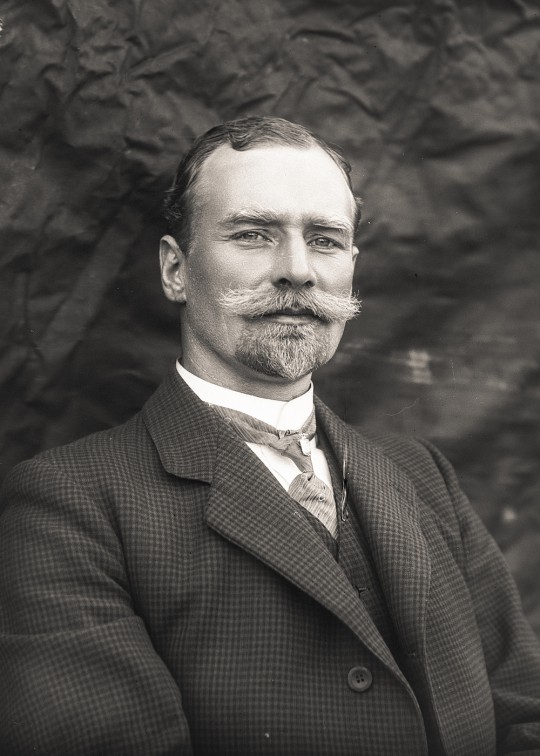Explorers
Hassel, Sverre Helge (1876-1928)
Hassel was a customs officer and polar explorer who participated on the second and third Fram expeditions.

Sverre Helge Hassel was born on 30 July 1876 and grew up in the working class district of Grønland in Kristiania (Oslo). His parents were “restaurateur and dance host” Martinius Pedersen Hassel (born in Skotselv 7 February 1851) and Elise Mathea Pedersen.
Sverre Hassel’s grandfather, Petter Nilsen, worked as a blacksmith at the Hassel ironworks at Modum, and he moved there with his wife Kristine Birgitte Johannesdatter between 1858 and 1863. They had seven children who grew up at the ironworks. Sverre’s father probably took the surname Hassel from here when the family moved to Kristiania.
Sverre Hassel was married to Helene Topper (born 1889) and they had two sons and a daughter.
As soon as Hassel was old enough, he went to sea to earn his mate and shipmaster certificate after some years of duty on board the training ship Christiania. This training vessel was originally built in Maine, US, under the name Star of the Empire, and it was used as trading vessel in the East Indies. A Norwegian committee bought the vessel from Great Britain where it had been renamed Lady Grey. In Norway it was rebuilt as a “training ship for boys who were destined to be sailors”. Hassel must have been one of the first boys who were lucky enough to join the vessel. In 1883, 127 young boys applied, only 30 were accepted. The boys came from all parts of the society, and the routines on board the ship were strict. Hassel’s experience from his years on the Christiania must have given him a good background for the discipline needed at the Framsome years later. It is said that captains who got rookie sailors from the Christiania could state that “The Christiania was a good school, both for the human nature and educationally.”
Between 1898 and 1902, Hassel participated as an all-round man on the polar ship Fram on Otto Sverdrup’s expedition to northwest Greenland and the islands north of Canada. The expedition mapped c. 150 000 km² of land by dog-sled, which made Hassel an expert dog driver. This was the greatest geographical mapping ever done on a polar expedition so far.
After returning to Norway in 1902, Hassel became a constable in the Navy, stationed in Horten. In 1904 he got an engagement as a customs assistant in Kristiansand. It was in Kristiansand that he joined Roald Amundsen’s expedition with the Fram in 1910 as an expert dog driver. Hassel had got one year’s leave from his engagement at the customs office, and his plan was to join the first part of the expedition when it apparently was heading towards the Arctic. But, when the Fram reached Madeira in the summer of 1910, and the crew was informed of Amundsen’s plan to conquer the South Pole, Hassel, as the others, accepted joining the expedition to the Antarctic. On December 14, 1911, he, Amundsen, Hanssen, Olav Bjaaland and Oscar Wisting were the first to reach the South Pole - Hassel driving one of the sledges.
Hassel said this about the expedition and the climate at the South Pole in an interview Roald Amundsen had with The New York Times 12 March 1912:
”It was not very cold, and near the pole itself we experienced fine weather. I have known it colder in Christiania. Without the dogs, however, we could not have got through and kept up our food supplies. Dog flesh is not the worst kind of food. The dogs are very ready to eat each other; indeed they are sometimes fonder of their companions dead than alive. Captain Amundsen is a wonderful man. We could never have accomplished the journey without him.”
Hassel said no to Amundsen’s offer to extend the expedition to the North Pole, and went back to customs work in Kristiansand and later in Farsund.
In the winter of 1913 he held over 100 lectures about the expedition to the South Pole. In October of 1916 he wrote a long letter to Fridtjof Nansen with the suggestion of making the Fram into a museum. It was Otto Sverdrup who later started this work.
In 1922 Hassel became a customs manager in Grimstad. He and Roald Amundsen kept their relationship, and in June 1928, 51 years old, Hassel died of a heart attack in Roald Amundsen’s garden while visiting his friend. Roald Amundsen himself died in an airplane crash only 12 days later.
Sources tell that Hassel was a low-voiced person, and that he was a loyal companion to Amundsen, despite the sometimes very negative characteristics he could give Amundsen in his South Pole diary. He represented Amundsen both in Hjalmar Johansen’s and Kristian Prestrud’s funerals. It has been said that he was a “rare skilled and sympathetic man with a strong personality who held his friends’ admiration and trust”.
Mount Hassel in Antarctica is named after him. He also has a street named after him in Stavanger, and the waters between Amund Ringnes Island and Ellef Ringnes Island in North Canada were named after him the "Hassel Sound".
- Expeditions
- Vessels
- Explorers
- Nansen, Fridtjof (1861-1930)
- Sverdrup, Otto Neumann Knoph (1854-1930)
- Amundsen, Roald (1872-1928)
- Amundsen, Anton (1853-1909)
- Balto, Samuel Johannesen (1861-1921)
- Baumann, Hans Adolf Viktor (1870-1932)
- Bay, Edvard (1867-1932)
- Beck, Andreas (1864-1914)
- Bentsen, Bernt (1860-1899)
- Bjaaland, Olav Olavsen (1873-1961)
- Blessing, Henrik Greve (1866-1918)
- Braskerud, Ove (1872-1899)
- Dahl, Odd (1898-1994)
- Dietrichson, Leif Ragnar (1890-1928)
- Dietrichson, Oluf (1856-1942)
- Doxrud, Christian (1881-1935)
- Ellsworth, Lincoln (1880-1951)
- Feucht, Karl (1893 – 1954)
- Fosheim, Ivar (1863-1944)
- Gjertsen, Hjalmar Fredrik (1885-1958)
- Gottwaldt, Birger Lund (1880-1968)
- Hansen, Godfred (1876-1937)
- Hansen, Ludvig Anton (1871-1955)
- Hanssen, Helmer Julius (1870-1956)
- Hassel, Sverre Helge (1876-1928)
- Hendriksen, Peder Leonard (1859-1932)
- Horgen, Emil Andreas (1889–1954)
- Isachsen, Gunnar (Gunnerius Ingvald) (1868-1939)
- Jacobsen, Theodor Claudius (1855-1933)
- Johansen, Fredrik Hjalmar (1867-1913)
- Juell, Adolf (1860-1909)
- Kakot
- Knudsen, Paul (1889-1919)
- Kristensen, Halvardus (1879 – 1919)
- Kristian Kristiansen (1865-1943)
- Kutschin, Alexander Stepanovich (1888 -1912)
- Lindstrøm, Adolf Henrik (1866-1939)
- Lund, Anton (1864–1945)
- Malmgren, Finn (1895-1928)
- Mogstad, Ivar Otto Irgens (1856-1928)
- Nilsen, Thorvald (1881-1940)
- Nordahl, Bernhard (1862-1922)
- Nødtvedt, Jacob (1857-1918)
- Olonkin, Gennadij (1898-1960)
- Olsen, Karenius (1890-1973)
- Olsen, Karl (1866-1939)
- Omdal, Oscar (1895-1927)
- Petterson, Lars (1860-1898)
- Prestrud, Kristian (1881-1927)
- Raanes, Oluf (1865-1932)
- Ramm, Fredrik (1892-1943)
- Ravna, Ole Nilsen (1841-1906)
- Riiser-Larsen, Hjalmar (1890–1965)
- Ristvedt, Peder (1873 – 1955)
- Rønne, Martin (1861-1932)
- Schei, Per (Peder Elisæus) (1875-1905)
- Schröer, Adolf Hermann (1872-1932)
- Scott Hansen, Sigurd (1868-1937)
- Simmons, Herman Georg (1866-1943)
- Stolz, Rudolf (1872- ??)
- Storm-Johnsen, Fridtjof (?-?)
- Stubberud, Jørgen (1883-1980)
- Sundbeck, Knut (1883 – 1967)
- Svendsen, Johan (1866-1899)
- Sverdrup, Harald Ulrik (1888-1957)
- Syvertsen, Søren Marentius (?? – 1923)
- Tessem, Peter Lorents (1875-1919)
- Tønnesen, Emanuel (1893–1972)
- Wiik, Gustav Juel (1878–1906)
- Wisting, Oscar (1871-1936)


